 According to a new study by comScore Networks, 82 million people – that’s nearly half of the European online population – used IM applications to chat online during February.
According to a new study by comScore Networks, 82 million people – that’s nearly half of the European online population – used IM applications to chat online during February.
Although impressive, Europe’s IM usage is dwarfed by messaging-crazy Latin America, where a massive 64 percent of the online population used IM during the same period.
Unusually, North Americans – a nation of people not exactly noted for their reluctance to chat incessantly – only registered 37 percent of the online population using IM.
Majestic Messenger
MSN Messenger was revealed to be the king of the IM applications, scooping up 61 percent of worldwide IM users.
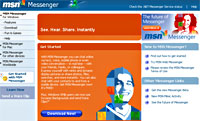 In Latin America and Europe, Messenger ruled supreme, registering usage rates of 90 percent and 70 percent (respectively) of IM users.
In Latin America and Europe, Messenger ruled supreme, registering usage rates of 90 percent and 70 percent (respectively) of IM users.
Messenger also scored highly in Asia Pacific, grabbing 70 percent of IM users.
Things are a lot tighter in the highly competitive North American market, where MSN Messenger, AOL/Aim and Yahoo! Messenger battled it out to each grab between 27 percent and 37 percent of IM users in February.
Skype surges
Skype is seen as a growing contender (it’s our IM tool of choice), with the program now being used by 14 percent of IM users worldwide.
 The VoIP/IM client application is proving to be a real hit in the Asia Pacific, where it has already garnered 26 percent of IM users, although it’s a different story in North America, where Skype can only claim 3 percent of the online population.
The VoIP/IM client application is proving to be a real hit in the Asia Pacific, where it has already garnered 26 percent of IM users, although it’s a different story in North America, where Skype can only claim 3 percent of the online population.
We love messaging
The study suggests that instant messaging has now become an integral part of people’s lives, with the 313 million worldwide users wasting away precious work hours increasing their productivity by staying online an average of about 6.3 hours a day.
 Two new studies into branding have produced two very different results, with a UK study declaring Microsoft the strongest brand in the known universe, while research in the US saw consumers slapping Microsoft down to near-bottom of their ‘most trusted’ list.
Two new studies into branding have produced two very different results, with a UK study declaring Microsoft the strongest brand in the known universe, while research in the US saw consumers slapping Microsoft down to near-bottom of their ‘most trusted’ list.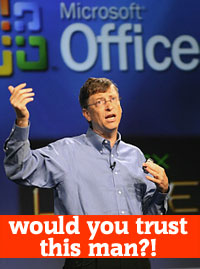 Bose, Dell, and Apple Score High On Trust
Bose, Dell, and Apple Score High On Trust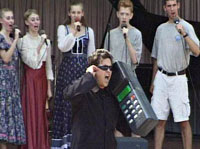 We didn’t think we needed a poll to find this one out, but a new poll in the States has found that just about everyone – including fellow mobile users – get annoyed by people talking loudly on their phones in public.
We didn’t think we needed a poll to find this one out, but a new poll in the States has found that just about everyone – including fellow mobile users – get annoyed by people talking loudly on their phones in public. Multimedia is for da kidZ
Multimedia is for da kidZ New figures from the International Federation of the Phonographic Industry (IFPI) reveal soaring global sales of digital music while overall music sales continue to decline. This in the same week that Gnarls Barkley and their musical ditty Crazy have become the first digital-only Number One in the UK Hit-parade, as we’d
New figures from the International Federation of the Phonographic Industry (IFPI) reveal soaring global sales of digital music while overall music sales continue to decline. This in the same week that Gnarls Barkley and their musical ditty Crazy have become the first digital-only Number One in the UK Hit-parade, as we’d  The growing single song download market (which accounted for 86 percent of purchases), has resulted in many listeners choosing to grab individual tracks rather than download entire albums.
The growing single song download market (which accounted for 86 percent of purchases), has resulted in many listeners choosing to grab individual tracks rather than download entire albums.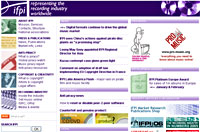 The biggest selling album of the year was “X&Y” by Coldplay, which could be heard being played – not too loudly, mind – in 8 million bedrooms, company cars and comfy living rooms.
The biggest selling album of the year was “X&Y” by Coldplay, which could be heard being played – not too loudly, mind – in 8 million bedrooms, company cars and comfy living rooms. Global revenue from music downloaded onto mobile phones went through the roof last year, with pundits predicting that the only way is up for the next five years.
Global revenue from music downloaded onto mobile phones went through the roof last year, with pundits predicting that the only way is up for the next five years. How to make a mint from mobile music
How to make a mint from mobile music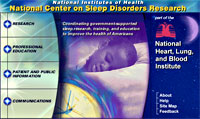 American teens are getting far less kip they’re supposed to, and a new study points the finger of blame at electronic gadgets in bedrooms.
American teens are getting far less kip they’re supposed to, and a new study points the finger of blame at electronic gadgets in bedrooms. The “Sleep in America” poll – which polled around 1,600 youths aged 11-17 and their caregivers – found that technological distractions were preventing kids from winding down and relaxing at the end of the day.
The “Sleep in America” poll – which polled around 1,600 youths aged 11-17 and their caregivers – found that technological distractions were preventing kids from winding down and relaxing at the end of the day. There may be almost 76 million sites stuffed full of six billion pages of information vying for our attention on the Web, but it seems that most surfers only choose to visit six sites on a regular basis.
There may be almost 76 million sites stuffed full of six billion pages of information vying for our attention on the Web, but it seems that most surfers only choose to visit six sites on a regular basis. Sadly, it seems that the days of random surfing are coming to a close, with the vast majority of Web users (95 per cent) going online with a specific destination in mind.
Sadly, it seems that the days of random surfing are coming to a close, with the vast majority of Web users (95 per cent) going online with a specific destination in mind. Bringing together public services from across eleven Whitehall departments, visitors to Directgov can unearth a mountain of useful information and services, from renewing driving licences, car taxes or passports , locating local services like schools, childminders and recycling and even planning journeys on foot, by car or by public transport.
Bringing together public services from across eleven Whitehall departments, visitors to Directgov can unearth a mountain of useful information and services, from renewing driving licences, car taxes or passports , locating local services like schools, childminders and recycling and even planning journeys on foot, by car or by public transport. According to a new report, future growth in the Japanese mobile market is to be focused on the only market segment yet to reach 100% saturation: the under 14s and over 55s.
According to a new report, future growth in the Japanese mobile market is to be focused on the only market segment yet to reach 100% saturation: the under 14s and over 55s. The biggest growth, however, comes from the 55-65 age group, with 1.62 million new customers expected in 2006.
The biggest growth, however, comes from the 55-65 age group, with 1.62 million new customers expected in 2006.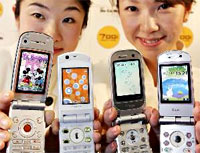 Blended ARPU is expected to continue sliding from $58 pcm in 2005 to $57 pcm by 2007 but this should be compensated by data ARPU which is predicted to rise from $15 pcm to $17 pcm over the same period, thanks to the growth of content market.
Blended ARPU is expected to continue sliding from $58 pcm in 2005 to $57 pcm by 2007 but this should be compensated by data ARPU which is predicted to rise from $15 pcm to $17 pcm over the same period, thanks to the growth of content market.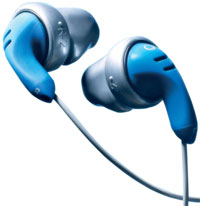 In-ear headphones (“earbuds”) like those sold with the iPod and other music players can increase the risk of hearing loss, according to a US audiologist (a what?!)
In-ear headphones (“earbuds”) like those sold with the iPod and other music players can increase the risk of hearing loss, according to a US audiologist (a what?!) We can certainly verify that some folks seem oblivious to the risk, blasting their music so high that we can hear the annoying “tssk chk tssk chk” leaking from in-ear phones over the thunderous rattle of a tube train.
We can certainly verify that some folks seem oblivious to the risk, blasting their music so high that we can hear the annoying “tssk chk tssk chk” leaking from in-ear phones over the thunderous rattle of a tube train.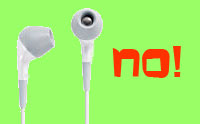 Garstecki proposes the 60%/60 minute rule as a solution – this involves listening to an MP3 device for no longer than about an hour a day and at levels below 60% of maximum volume.
Garstecki proposes the 60%/60 minute rule as a solution – this involves listening to an MP3 device for no longer than about an hour a day and at levels below 60% of maximum volume. Broadband adoption in the UK may soon be reaching its peak, according to a new report from Datamonitor.
Broadband adoption in the UK may soon be reaching its peak, according to a new report from Datamonitor. Although we’re nearly broadbanded out in Europe, the report sees excellent opportunities for growth in less mature markets.
Although we’re nearly broadbanded out in Europe, the report sees excellent opportunities for growth in less mature markets.